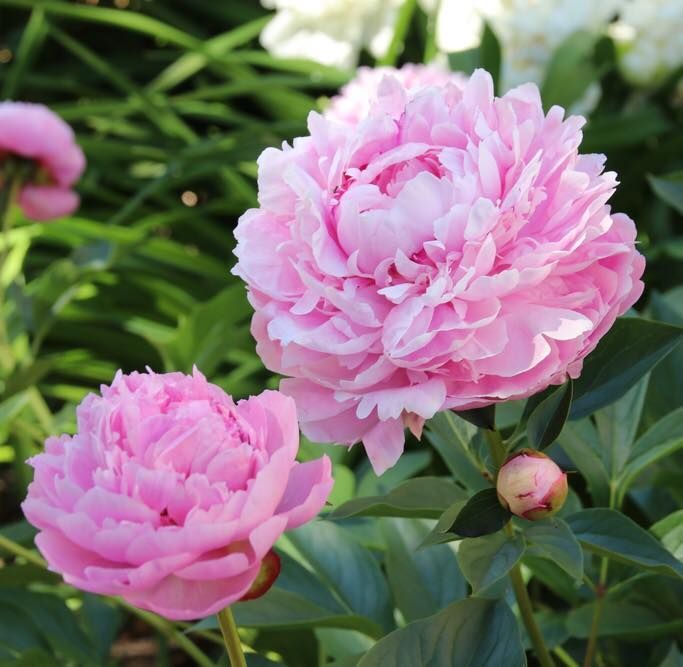Paeonies do best in a cooler climate that has cold winters and mild summers
as seen in the bright blue areas on our map.

Paeonies (or Peonies, depending on where you come from ) are one of the most romantic plants in the world.
They are also called Chinese Peony & Peony Rose although they are not related to Roses at all however their large rose-like, fragrant flowers make them a favourite the world over. They are rare and difficult plants to grow, so are a triumph for any gardener when grown well. They are mostly used for perennial borders because of their profusion of bloom and their attractive foliage which is tinged a bronze/maroon colour in spring, becomes green as the spring progresses.
Paeonies come in 2 forms: Herbaceous Paeonies which grow to approximately 1 metre tall, and Tree Paeonies which can grow up to 2-3m high). Peonies flower from late spring to summer and die down over winter, sending up new shoots each spring. Chinese herbaceous peonies are among the world's oldest garden plants.

Paeonies do best in a cooler climate that has cold winters and mild summers
as seen in the bright blue areas on our map.
Herbaceous paeony tubers are generally available in early spring. Potted specimens can be purchased at different times throughout the year (depending on availability from growers).
They love well-drained soil with plenty of added organic matter and prefer a lightly alkaline soil (ideal pH is around 7-7.5).
If you have acidic soil, add some dolomite lime to your planting hole.
*You can purchase a Soil Testing Kit in-store or bring a soil sample into us to be tested.
Plant your Paeonies in a sheltered position as wind can damage the flower stems and hot sun will scorch flowers. Paeony tuber crowns should be set 2-3cm below the surface of the soil taking care not to damage any new growth buds or roots.
*Apply mulch around the base of the plant (make sure not to touch the main stem) to help protect the roots.
*Spent flowers should be removed regularly. Allow leaves to die down naturally in autumn before cutting back in late autumn.
*You can divide tuber clumps in early autumn when the plant is entering dormancy if you wish but the clump can be left undisturbed for many years without causing any problems.
If growing paeonies for cut flowers you should break off the side buds so that each stem only has one main bud. This will ensure you have larger, more beautiful blooms. Flowers should be cut when the bud is still a tightly packed ball - they will open up over the next day or two and will last in water for up to a week.
Tree peonies are harder grow. We recommend you plant in raised garden beds as they provide good drainage, which is essential. As with her-baceous peonies, add some dolomite lime when planting - this is essential for all peonies to grow well.
They will grow in the sun but do best in a protected spot as they cannot withstand the scorching sun and also require protection from the wind as stems can snap in strong wind.
Mulch to protect root zone.
Recommended varieties that are thought to be easier to grow:
'Souvenir de Maxime Cornu' also known as 'Kinshe' - large, full double yellow tipped with orange
'Happy Days' - yellow flower
'Black Panther' - black-red flower
'Thunderbolt' - dark red flower

Paeonies really don’t like having soggy feet, so make sure you plant them somewhere
with good drainage.
They’re also not fans of having their roots messed with too much, so try to avoid digging
around them once they’re in the ground. Pick your planting spot carefully, and they’ll
reward you with beautiful blooms year after year.
The root and bark of several peony species have been used in traditional Chinese medicine for centuries.
The chemical paeoniflorin, is contained in the bark of the plant and is believed to be useful in controlling bleeding, diarrhoea and intestinal diseases as well as reducing spasms and lowering temperatures.
Some European countries use peony flowers to make a tea for use as a cough remedy, as well as a treatment for haemorrhoids and varicose veins. - quite a diverse range there!
Phone: 03 6273 0611
Email: sales@stonemans.com.au
Address: 94 Grove Road Glenorchy, TAS, 7010
Mon - Fri:
9:00 am - 5:00 pm
Sat - Sun:
9:00 am - 4:00 pm
Public Holidays:
10:00 am - 4:00 pm
Closed:
Christmas Day, Boxing Day, New Year's Day and Good Friday